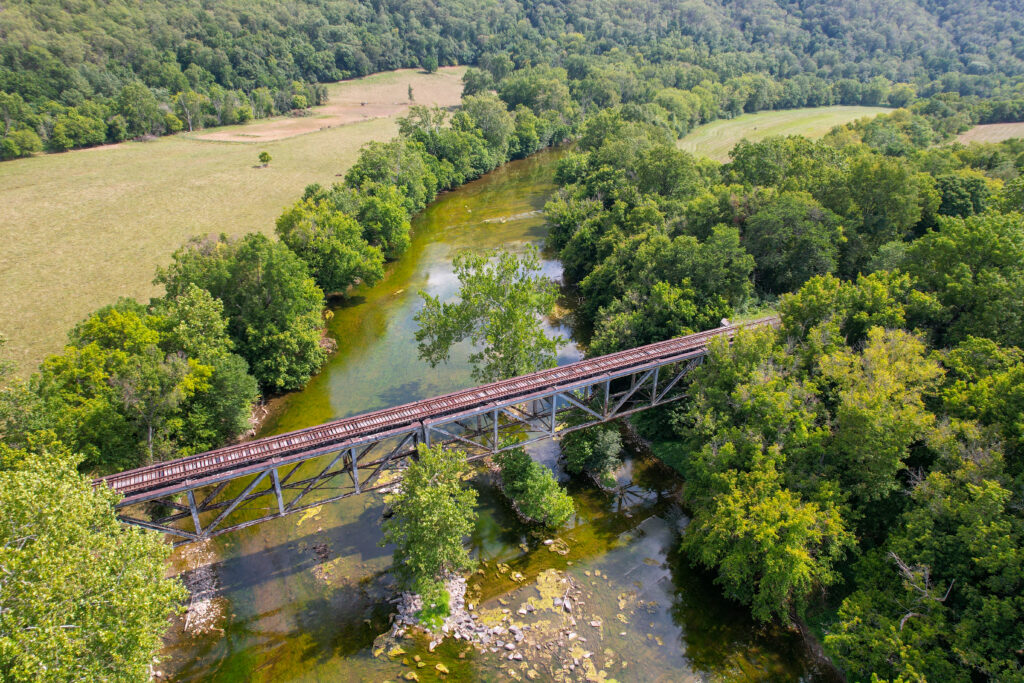An aerial view of the bridge over the North Fork of the Shenandoah River. (Courtesy of Friends of the Shenandoah Rail Trail)
A proposed plan to transform the Shenandoah Valley Railroad Corridor into a rail-with-trail is chugging along, but the funds to improve the corridor are at the center of discussion about whether or not shortline rail operators vying to restore the railroad can use $35 million in state money for repairs to the nearly 50-mile rail track that runs from Front Royal to Rockingham County.
An unused rail corridor in the Shenandoah Valley sparks a fight over what’s next
Last year, the state appropriated up to $35 million, as part of a $245 million package, to “buy land for the proposed rail trail and conduct initial planning and site development.” Language in the budget noted that any land acquisition for the trail “shall not preclude the consideration of options to maintain rail transportation in the corridor.”
In June, a proposal was published for bids to revive the rail line that suggested to applicants that the winning rail operator could use $35 million in state funds to make needed repairs to the historic railroad, which was founded in the 1850s.
According to Jessica Cowardin, a Virginia Department of Transportation spokeswoman, the agency would “not view repairing the rail line as an eligible expense for this directed spending” under the budget language.
How the rail-with-trail proposal developed
In 2021, Virginia completed a field survey and produced a study on the feasibility of developing a linear park alongside the railway. However, after interest grew among community organizations, the agency launched a second assessment to consider converting the corridor into a rail with trail.
Amid a decline in freight service, Norfolk Southern Corporation discontinued certain corridor sections in 1989. More than 30 years later, the Shenandoah Valley Battlefields Foundation and Norfolk Southern have negotiated a letter of intent to purchase the corridor for $23 million, Northern Virginia Daily reported in February. Foundation CEO Keven Walker and the Shenandoah Rail Corridor Coalition have argued that the corridor could be restored to include a restored rail line and a recreational trail.
Walker, who is familiar with the negotiations and plan to solicit shortline rail operators, said in an earlier phone call with the Mercury that the proposal was necessary to meet the federal common carrier responsibility requirements that are part of the agreement with Norfolk Southern.
He said the process has yielded “multiple proposals” from rail operators, five of which are “very well known, very well respected, and have the means, the ability… and desire to operate the line.”
The proposal to applicants made references that suggested the selected railroad operator would not be responsible for the repair costs. A projected amount for the repairs was not included, but in a May analysis, initial repair and replacement costs were estimated to be more than $7 million.
“Due to the current track conditions, this is assumed to be a phased approach expected to take a minimum of three years, and be primarily funded by a combination of state and federal funding for capital track rehab as well as parallel trail construction,” part of the proposal read.
The proposal also stated that “funding for major capital needs, including acquisition, bridge repairs, or major capital tie replacement programs are not assumed to be the responsibility of the operator.”
Walker did not respond to follow-up questions about the language in the proposal.
According to the U.S. Department of Transportation, rails-with-trails projects have grown from 65 in 2002 to 434 in 2018.
Don Hindman, project director for the Shenandoah Valley Rail Trail Exploratory Partnership, an 18-member group that supports converting the corridor into a trail, said the idea of reviving the rail line and also building a parallel trail could be expensive and instead suggested that the corridor should be a multi-use trail.
“Well, I’m incredulous that a nonprofit can try to contract a for-profit railroad company on property that they don’t own, and on property that they know at least the population here has plans for a rail-trail,” Hindman said.
SUPPORT NEWS YOU TRUST.

